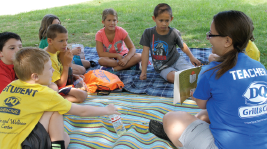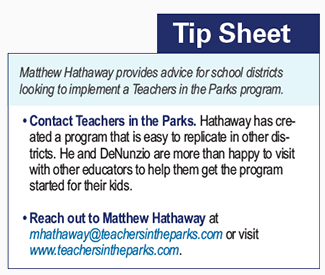Voice: September 2017
This story is part of a regular series, “Learning Lessons: Great ideas, Great schools,’’ that features educators who are doing great things or conducting great programs in Pennsylvania’s public schools. For other stories in the series go to www.psea.org/learninglessons.
For more information about how you can prevent the summer slide and bring Teachers in the Parks to your students, visit www.teachersintheparks.com or contact Matthew Hathaway at mhathaway@teachersintheparks.com.
On a summer day at the Antietam Pool in Exeter Township, children are gathered in groups – on a blanket under the speckled cover of tree branches, in a circle around a rainbow-colored parachute, and on a wooden picnic table. Another group is gathered along the edge of the shallow end of the pool, dangling their feet in the cool water.
It may look like a typical, sunshine-filled August day. Kids are out of school – happy and carefree at the community pool. But upon closer inspection, these children are learning. And they are loving it. This is Teachers in the Parks.

Meeting a need
The Teachers in the Parks program is the decade-long labor of love of Matthew Hathaway, a fourth-grade teacher in the Exeter Township School District, Berks County. In 2004, Hathaway was a young teacher with students who needed extra help over the summer. These six students met Hathaway on his parents’ porch, and together they would walk to the community park, where he would provide supplemental learning over the summer.
While at the park, he noticed there were other kids he could help, too. They were already at the park for summer programs.
And Hathaway knew that he could help them because he had focused his research on the detrimental effects of the “summer slide’’ as part of his masters degree program at Millersville University.
“Children who don’t bridge the summer gap lose about 25 percent of instructional time every single year. And that adds up,” Hathaway said. “Children who bridge the summer gap gain 25 percent more instructional time working toward any given grade level standard every single year prior to state testing. Imagine how that success compounds over the elementary years.”
In the summer of 2010, Hathaway got a few teachers together, and they taught 18 kids in the local park. The program has since grown to serve hundreds of students at different locations in the community.

Creating a model that works
The traditional summer school model is a deficit model, placing children who struggle in a setting away from their peers for remedial learning. It creates a negative stigma toward summer learning, which doesn’t help anyone succeed.
“Children don’t want to be at school over the summer. And teachers don’t either,” Hathaway said. “But that doesn’t mean that children don’t want to learn and teachers don’t want to teach. So, if we can share our gift in public education, which is instruction, we can get to the heart of what we do right away in a natural environment like a park or a pool. We can make tremendous gains for children.”
Taking the learning to places where students already spend time in the summer takes away the negative stigma, and alleviates unnecessary facilities and transportation costs. Students of all levels are welcome at the Teachers in the Parks program. Seeing their successful peers at TIPs helps struggling students feel more comfortable with summer learning.
“This program benefits the whole child,” said Karen DeNunzio, K-12 Literacy Coach in the Exeter Township School District. “It started with the thought that we need to bridge the academic to give that success and prevent the summer slide. But as we have gone through this program over the years, we are seeing benefits way beyond the academia. We are seeing students coming to school in August and September more confident as learners, and socially better with the relationships they have with both their peers and teachers.”
Building community support
Hathaway has found support in many areas of the community – from local businesses to the school district administration.
“When you are part of a community instead of just trying to do this by yourself in a school building, there are so many advantages,” he said. “You develop community partnerships that can help provide funding. When you’re visible in the community, people ask you what you’re doing and they want to support you.”
The surrounding community can also benefit from a program like Teachers in the Parks.
“We serve more than 100 children in our program at this pool, which is bringing people around the community pool. This is only helping enrollment in pool programs,” Hathaway said. “It’s creating a real community around summer learning, instead of isolating ourselves at the school buildings.”
Bridging a gap
DeNunzio has helped Hathaway build a curriculum that benefits all students. They looked at what students learned at the end of one school year and what they would be learning at the start of a new year, and the content for the program creates a bridge between grade levels.
“We identified some core components that we wanted teachers to delve into, instead of having a breadth of curriculum, as they do in a normal school year,” DeNunzio said.
Teachers are provided with guidelines of what to teach, but the “how” is left up to them.
“We didn’t want to keep teachers from being creative with how they taught,” she added.
A program for all
Hathaway believes Teachers in the Parks is a program that could work anywhere with a little bit of adaptation.
“Our organization believes that all children deserve access to summer learning,” he said. “This has been a 10-year project to try to create a model that we could take anywhere. The trick to all of this is finding where children are over the summer.”
In communities like Exeter Township, these are the community pools, parks, and libraries. In a different community, it may be a YMCA or a community recreation program. The key is meeting the children where they are, and making it easy for parents and caregivers.
“We have to appreciate the gifts that we bring,” he said. “Teachers don’t have to provide all-day childcare. There are childcare providers already over the summer. The gift that public education brings is an expertise in instruction. So, if we can build relationships with our community and share our gift with the community, we can bridge the summer gap.”



